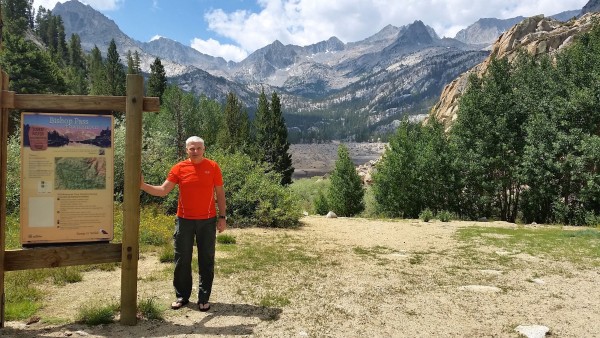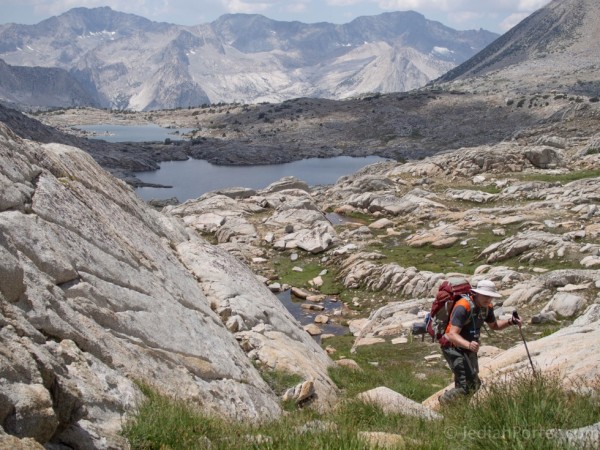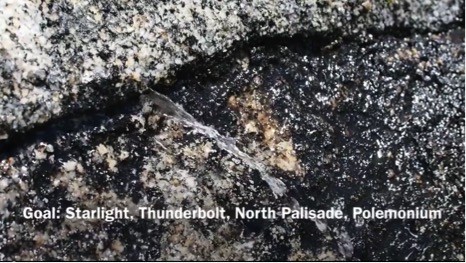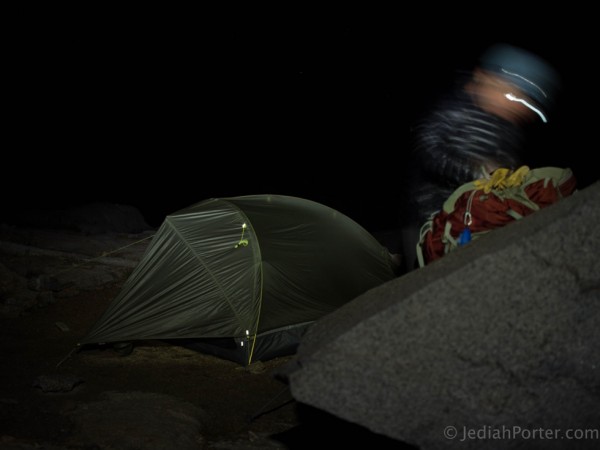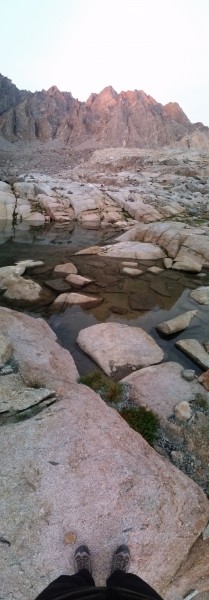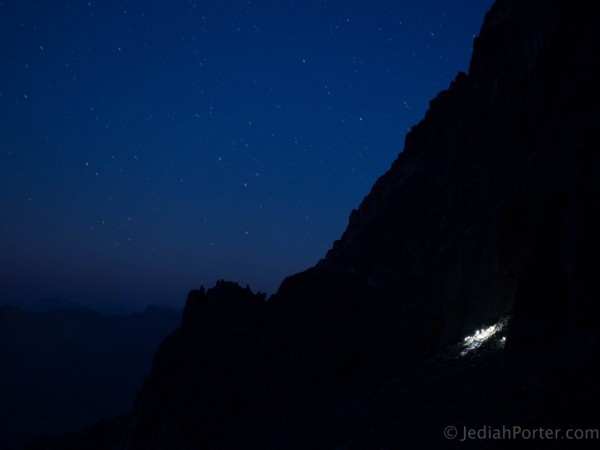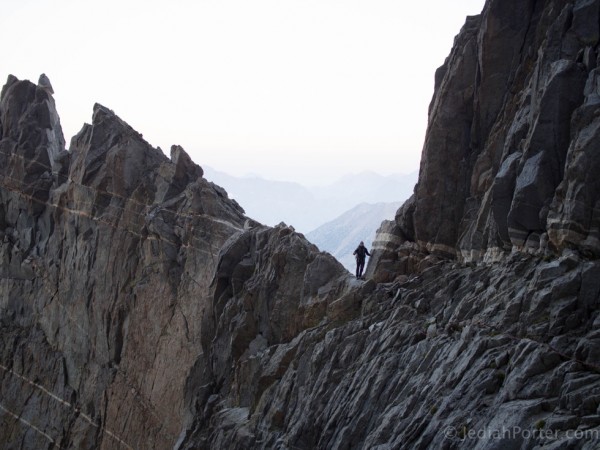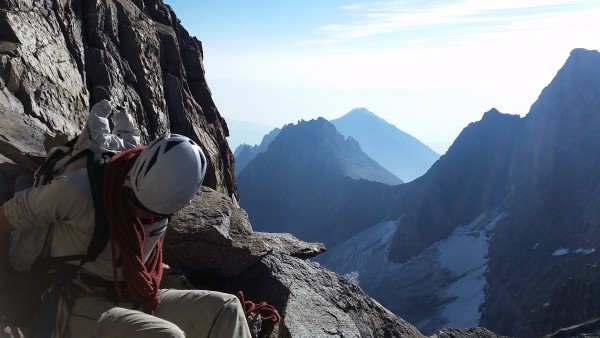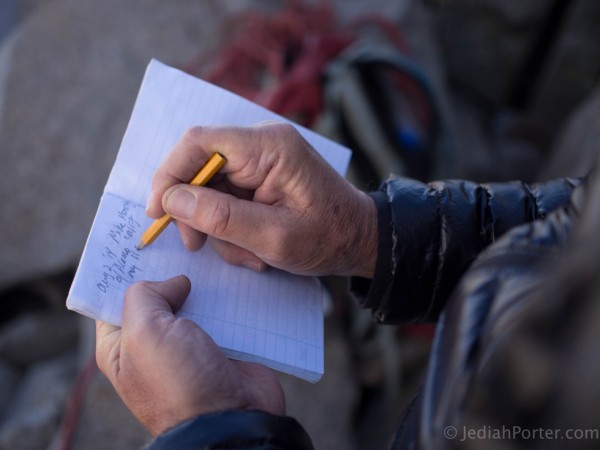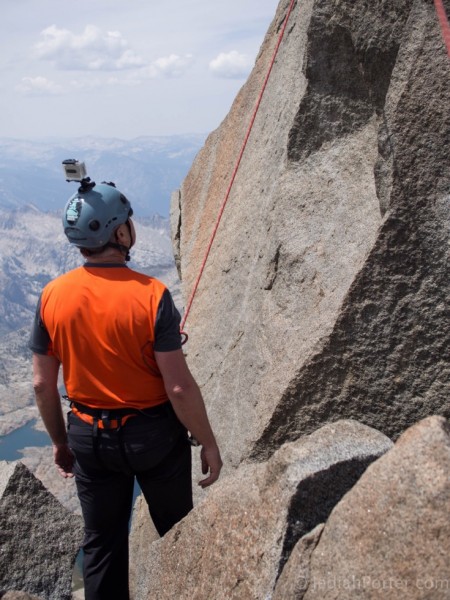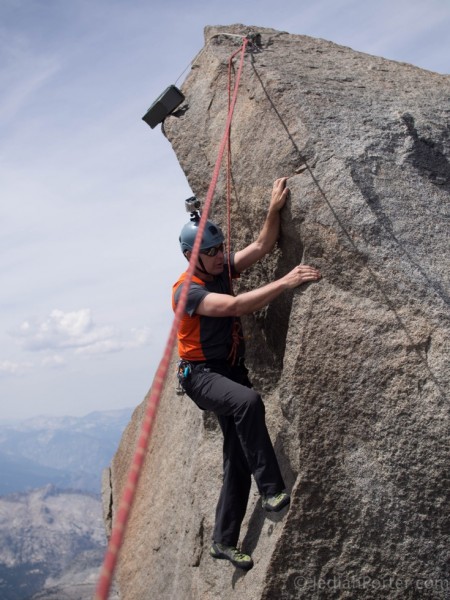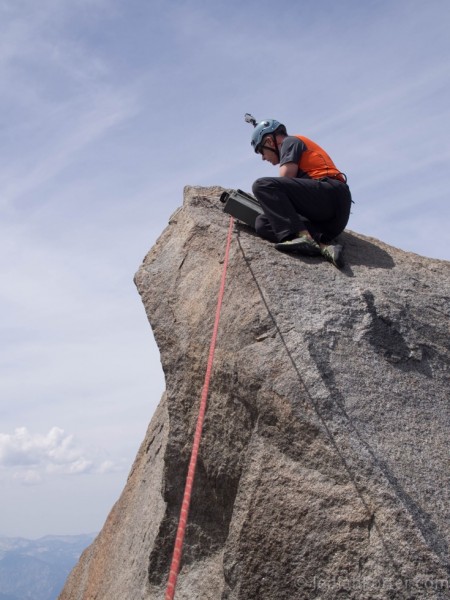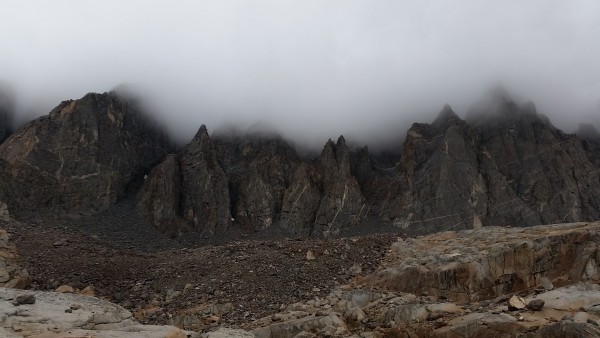The goal for this trip was ambitious (for me), to climb Starlight and Thunderbolt one day and then North Palisade and Polemonium the next day. I have slowly worked my way up the 14er ‘difficulty level’, advancing towards the more challenging peaks in the Palisade Range. Having done 5 trips to the Palisades over the last 7 years and I’m always in awe of the string of ethereal perches/summits along the range more so than any of the other singular California 14er. It’s taken a while to compile the photos and videos from this trip, thus the delayed report.
I took up rock climbing 8 years ago to be able to climb the more difficult 14ers. That effort paid off on this trip during the weekend of August 1-3, 2014 when I completed my 11th (Starlight) and 12th (Thunderbolt) of the 14ers with super-guide Jediah (Jed) Porter. Not too bad for turning 60 a few months beforehand. These are arguably two of the most technically difficult. My first 14er was with Warren Yamaguchi over 10 years ago at Mt. Whitney, a walk in the park compared to the more challenging 14ers.
I had met Jed a few years before at the top of Thunderbolt pass after he successfully guided a client up Thunderbolt and back. I took his card, knowing I’d likely need his skills on the future more demanding Palisade 14ers.
I left the South Lake Trailhead around 9am on July 31, 2014 (a day before Jed) in order to acclimatize and hiked towards Bishop pass. The multi-year drought has taken its toll on the beautiful small lakes along the trail.
I reached Bishop Pass (approx. 12k feet) around 1:00pm and set up camp with my brand new Mountain Hardware lightweight 2lb backpack tent. As soon as I finished setting up camp,
a major thunder lightning storm covered the Bishop Pass area and dropped hail (some the size of grapes) right outside my camp.
[Click to View YouTube Video]
Several lightning strikes hit near my tent, didn’t know if it was better to get a away from the tent’s metal poles or stay put, so I stayed put and watched the storm through the tent door. I’ve since learned it’s best to abandon your tent – from ‘howstuffworks.com: “While you might feel like staying in your tent to get out of the rain, lying down in your tent will increase the risk that you'll be struck by ground current from lightning. Even if you're camping in a heavily wooded area, where you're less likely to be struck, you'll still run the risk of getting hit by a ground current or secondary strike. So, even though it might be uncomfortable, in the middle of a thunderstorm, it's best to abandon your tent.”
The storm passed within 2 hours and I actually had a great night’s sleep thanks to Diamox and my new thicker sleeping pad.
The next morning (Aug. 1) I hiked the 5 minutes from the campsite and met Jed precisely at 12:00 noon at the Bishop Pass sign where we left directly for a campsite just on the far side of Thunderbolt pass as one of the small tarns below the pass. I have done the Thunderbolt pass big boulder scramble several times and always found it intimidating with a heavy pack, once slipping backwards and landing on my pack. Thanks to Jed, we took a low approach most of the way towards Thunderbolt pass and avoided most of the boulder hopping, making it to Thunderbolt Pass in a little over 2 hours.
About halfway between Bishop Pass and Thunderbolt Pass Jed stopped at a natural spring the shoots a steady stream of water between two rocks. Jed has noticed this same recurring spring on almost every one of his trips through this spot.
Natural Spring –
We set up camp where Jed made his famous steak and mashed potato backpack dinner (as he did on the successful Mt. Russell trip in Sept. 2013) and we got an early nights rest.
The next morning, we awoke at 3am
and packed up the climbing gear and had a light breakfast, leaving camp before 4am. We hiked up the 3rd chute to the right of the main Thunderbolt chute towards Starlight, i.e. there’s 1 chute between Thunderbolt main chute and Starlight chute. Veteran guide thinking is that if you’re coming down a different route, it’s easier to hike up the more difficult chute and then come down the easier chute (in this case, the easier main Thunderbolt chute).
Palisade Range vertical panorama taken the night before -
About an hour after leaving camp, Jed took this photo of another climbing group from Peregrine Semiconductor headed up Thunderbolt chute at 5am.
After reaching the top of the chute going to the right, you enter a traverse section near the Palisade Ridge –
Here’s the jaw-dropping view looking east towards Palisade Glacier from the ridge below Starlight with Jed in the foreground –
The 30 foot Starlight peak/monolith looks very intimidating, but it’s actually an easy 5.6 rating and relatively easy to wrap your arms around the top section of the pinnacle. Standing on the top of this 2 ft. square perch is a highlight of all my trips and a very rewarding experience.
Starlight Go-Pro Climb Video HD -
[Click to View YouTube Video]
Sitting on Starlight Peak –
Signing the Starlight register –
After Starlight, we headed along the ridge, doing some steep down-climbing and a short 20 foot drop down a 4 foot wide chimney over to the base of Thunderbolt.
Studying the Thunderbolt moves -
In order to climb Thunderbolt with protection (on-belay), you need to lasso a rope around the monolith. Jed did this quickly and accurately by gathering several small loops of rope in each hand and simultaneously tossing them over top of the summit, as shown here in this video.
[Click to View YouTube Video]
Putting on my climbing shoes again and setting up the go-pro, I started to climb the peak. It’s a daunting step/reach out over a 1000 ft. drop to place your left foot at the start of the 5.9 crux move on the base of Thunderbolt, certainly more daunting if you aren’t on belay.
Crux move on Thunderbolt –
Climbing Thunderbolt –
and the Go-pro video of Mike climbing Thunderbolt Peak -
[Click to View YouTube Video]
Signing the Thunderbolt register –
After summiting Thunderbolt, we head towards the Thunderbolt chute that exits at Thunderbolt pass. Along the way we meet the Thunderbolt group from Peregrine Semiconductor and a climber in tennis shoes ‘jogging’ the ridge in a mission to finish all the 14ers in a record time. We took about 2.5 hours to reach camp at 2pm.
C2C (Camp to Camp) in 10+hours, not bad for me, although on a prior trip Jed had done just Thunderbolt up and down in 3+ hours.
The next day, Sunday, August 3rd, we had planned to summit North Pal and Polemonium, but awoke to rain, which steadily worsened and turned to sleet.
We decided to head back to Bishop while the freak freezing August storm pounded us all the way down the Bishop Pass trail to the South Lake Trail-head, turning it into a 6 in deep stream most of the way to South Lake and drenching my pack, boots, clothes – freezing cold. Had to keep moving to keep my body heat up.
One of the other benefits of using an experienced guide (besides the route finding and safety benefits) is that Jed compiled a series of videos he edited on his iPhone into a mini trip video. This includes video of the natural spring between Bishop Pass and Thunderbolt Pass.
[Click to View YouTube Video]
Thanks to Jed for being a great lead/guide and to the Sierra Mountain Guides staff for a memorable trip. After this trip, I have 3 14ers left, North Palisade, Polemonium and Middle Palisade.
Mike Moody – Alamo CA
